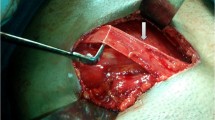Abstract
Purpose
Being a relatively new entrant into our practice, mesh repair has not been compared with previously existing tissue-based techniques in our setting. This study is set out to compare darning with Lichtenstein technique of inguinal hernia repair in terms of frequency of post-operative complications, recovery and cost.
Method
Patients with uncomplicated, primary inguinal hernia were randomized to have their hernias repaired either by the Lichtenstein or darning technique. Details of their socio-demographic, hernia characteristics and intra-operative findings were recorded. Postoperatively patients were assessed for pain, wound site complications and recurrence. Both direct and indirect costs were calculated. Mean duration of follow-up was 7.5 months.
Result
Sixty-seven patients were studied. Thirty-three had Lichtenstein repair while 34 had darning repair. Lichtenstein repair was associated with less post-operative pain, less analgesic requirement, and shorter time of return to work activities, these were all statistically significant (p < 0.05). Frequency of post-operative complications was comparable in both groups with wound haematoma and scrotal oedema being the commonest. There was no recurrence in any of the groups. Total cost was comparable between the two groups.
Conclusion
Lichtenstein is superior to darning in terms of post-operative recovery while both techniques are comparable in terms of frequency of early post-operative complications and total cost.




Similar content being viewed by others
References
Bekker J, Keeman JN, Simons MP, Aufenacker TJ (2007) A brief history of the inguinal hernia operation in adults. Ned Tijdschr Geneeskd 151(16):924–931
Zsolt B, Csiky M (2001) Recurrence rate in Bassini operation after five years. Magy Seb 54(5):307–308
Shouldice EB (2003) The Shouldice repair for groin hernias. Surg Clin N Am 83(5):1163–1187
Kingsnorth AN, Gray MR, Nott DM (1992) Prospective randomized trial comparing the Shouldice technique and plication darn for inguinal hernia. Br J Surg 79(10):1068–1070
Panos RG, Beck DE, Maresh JE, Harford FJ (1992) Preliminary results of a prospective randomized study of Cooper’s ligament versus Shouldice herniorrhaphy technique. Surg Gynecol Obstet 175(4):315–319
Moloney GE, Gill WG, Barclay RC (1948) Operations for hernia; technique of nylon darn. Lancet 2(6515):45–48
Hernias AJ, Zinner MJ (eds) (1997) Maingot’s abdominal operations, 10th edn. Appleton and Lange, Conneticut, pp 479–580
Moloney GE (1972) Darning inguinal hernias. Arch Surg 104(2):129–130
Farooq O, Batool Z, Bashir R (2005) Prolene Darn: safe and effective method for primary inguinal hernia repair. J Coll Phys Surg Pak 15(6):358–361
Olasehinde O, Adisa AO, Agbakwuru EA, Etonyeaku AC, Kolawole AO, Mosanya AO (2015) A five year review of darning technique of inguinal hernia repair. Niger J Surg 21(1):52–55
EU Hernia Trialist Collaboration (2002) Repair of groin hernia with synthetic mesh: meta-analysis of randomized controlled trials. Ann Surg 235(3):322–332
Arowolo OA, Agbakwuru EA, Adisa AO, Lawal OO, Ibrahim MH, Afolabi AI (2011) Evaluation of tension-free mesh inguinal hernia repair in Nigeria: a preliminary report. West Afr J Med 30(2):110–113
Usoro NI, Agbor C, Emelike K, Bamidele A (2008) Early outcome of inguinal hernia repair using ultrapro mesh in University of Calabar Teaching Hospital Nigeria. Internet J Third World Med 6(2):2
Breivik H, Boorchgrevink PC, Allen SM, Rosseland SA, Romundstad L, Hals EK et al (2008) Assessment of pain. Br J Anaesth 101(1):17–24
Bailey IS, Karran SE, Toyn K, Brough P, Ranaboldo C, Karran SJ (1992) Community surveillance for complications after hernia surgery. Br Med J 304:469–471
The World Bank development report, 2012
Carbonell JF, Sanchez JL, Peris RT et al (1993) Risk factors associated with inguinal hernias: a case control study. Eur J Surg 159:481
Flich J, Alfonso JL, Delgado F et al (1992) Inguinal hernia and certain risk factors. Eur J Epidemiol 8:277 PMID: 1644149
Hair A, Paterson C, Wright D, Baxter JN, Dwyer PO (2001) What effect does the duration of an inguinal hernia have on patient symptoms. J Am Coll Surg 192(2):12–19
Imamuddin B, Sher MS, Iasmeen I, Ghulam S, Rajib AD (2010) Moloney darn repair: versus Lichenstien mesh repair comparison of Cost effectiveness and complications. Med Channel 16(1):81–84
Hussain A, Aamer N, Asad MM (2007) Pakistan armed forces medical journal 57(1):23–27
Chakraborty S, Mukherjee A, Bhattacharya M (2007) Tension-free inguinal hernia repair comparing’darn’with’mesh’: a prospective randomized controlled clinical trial. Indian J Surg 69(2):52–56
Kaynak B, Celik F, Guner A, Guler K, Kaya MA, Celik M (2007) Moloney darn repair versus lichtenstein mesh hernioplasty for open inguinal hernia repair. Surg Today 37(11):958–960
Farah S, Brygel M (2012) Short term pain and return to activities following Lichtenstein inguinal hernia repair. Internet J Surg 28(2):140053
Zedan AM (2009) Inguinal hernioplasty by darning versus prosthetic mesh. Tikrit Med J 15(1):158–162
Koukourou A, Lyon W, Rice J, Wattchow DA (2001) Prospective randomized trial of polypropylene mesh compared with nylon darn in inguinal hernia repair. Br J Surg 88(7):931–934
Sanchez-Manuel FJ, Lozano-Garcia J, Seco-Gil JL (2012) Antibiotic prophylaxis for hernia repair. Cochrane Database Syst Rev 2007(3):CD003769
Farah S, Brygel M (2012) Short term pain and return to activities following Lichtenstein inguinal hernia repair. Internet J Surg 28(2):14005
O’Dwyer PJ, Alani A, McConnachie A (2005) Groin hernia repair: postherniorrhaphy pain. World J Surg 29(8):1062–1065
Author information
Authors and Affiliations
Corresponding author
Ethics declarations
Conflict of interest
Olasehinde O, Lawal O.O, Agbakwuru E.A, Adisa A.O, Alatise O.I, Arowolo A.A, Adesunkanmi A.R.K, Etonyeaku A.C declare no conflict of interest.
Statement of human and animal rights
Ethical approval was obtained from the Ethics and Research committee of the Obafemi Awolowo University Teaching Hospitals Complex, Ile‐Ife. This study was conducted in accordance with the ethical standards of the ethical committee of the Obafemi Awolowo University Teaching Hospitals Complex Ile‐Ife, Nigeria.
Informed consent
Informed consent was obtained from all the patients in this study.
Rights and permissions
About this article
Cite this article
Olasehinde, O., Lawal, O.O., Agbakwuru, E.A. et al. Comparing Lichtenstein with darning for inguinal hernia repair in an African population. Hernia 20, 667–674 (2016). https://doi.org/10.1007/s10029-016-1498-2
Received:
Accepted:
Published:
Issue Date:
DOI: https://doi.org/10.1007/s10029-016-1498-2




